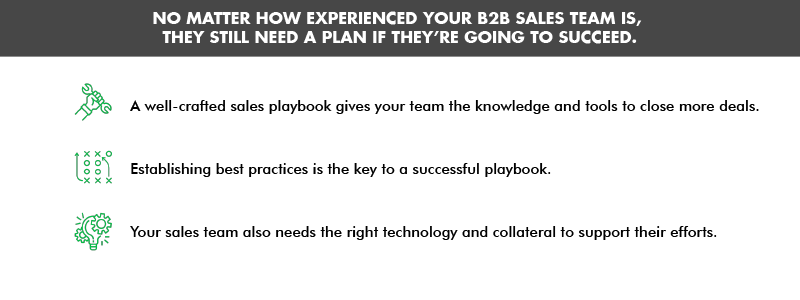How to Craft an Unbeatable Playbook for B2B Sales

No matter how experienced your B2B sales team is, they still need a plan if they’re going to succeed.

It’s no secret: A well-developed sales playbook gives your team the data and tools they need to get the job done. Without a playbook, sales departments are far more likely to find themselves missing out on opportunities to cross-sell, falling short of their goals, and even losing valuable accounts altogether. But with a playbook at the ready, your sales reps will understand how to sell your company’s unique vision to any client, big or small.
In this guide, we’ll walk you through the process of setting up a well-structured sales playbook that will help your reps convert the most skeptical B2B prospects.
Sales process and methodology
At its core, a sales playbook is a set of best practices that guide your team through the entire sales process, from mining new prospects to making the pitch to closing the deal. It should include scripts, guides, and buyer personas, as well as common objections and strategies for addressing them. Sales reps can also use the playbook to become more educated about your company’s priorities and the key performance indicators (KPIs) that you’ll use to evaluate their performance.
So how do you develop this crucial document? The first step is to set up a standardized sales process that:
- Brings your team together under a single sales approach that works for your company
- Encourages reps to make recommendations for improvements
- Standardizes training for all new and existing employees
- Enables your reps to provide remarkable customer service
Next, define your playbook methodology. There are a number of options to consider, including the following:
- Consultative selling. Also referred to as “needs-based selling,” this method puts reps in the position of advisors, recommending a variety of solutions based on client needs, rather than selling a specific product. This works best for potential clients who have already done some research but need guidance on which way to go.
- SPIN selling. This approach encourages reps to ask their prospects questions from four categories: situation, problem, implication, and need-payoff. This highlights the customer’s challenges and is usually best applied to companies whose products have long sales cycles, complex implementation, and many stakeholders. Reps using this system may encounter prospects who claim they don’t actually have a problem or who have a problem that seems intractable.
- Challenger selling. This method is a bit more aggressive and focuses on teaching potential customers what they need and why your company has the solution. It relies on a more confrontational approach, challenging the client’s assumptions and introducing them to a new way of looking at things.
Regardless of the method you choose, remember that a well-made playbook allows reps to customize solutions for individual client needs. When put to good use, a sales playbook can win over new prospects, cross-sell current clients, keep accounts that are in danger of expiring, and bring dissatisfied customers back into the fold.
Just remember that nothing in your playbook is carved in stone. To keep your playbook as relevant and useful as possible, you’ll want to continually gather feedback from reps in the field to determine what works and what doesn’t – and revise accordingly.
Sales technology and tools
Your sales playbook should also familiarize your team with any sales tools and technology your company uses. And if you aren’t using sales technology, you should be.
According to a recent report, successful companies are 1.4 times more likely to make full use of sales technology tools than their less successful competitors. Customer relationship management (CRM) software, for example, allows you to qualify and prioritize promising B2B leads and leverage customer analytics to anticipate their needs and deepen the relationship. A CRM can also help your team guide their leads all the way through the sales funnel. It tracks each relationship closely to quickly identify when a prospect has gotten stuck and needs extra attention.
As handy as a CRM can be, however, it doesn’t do any good if your team doesn’t understand why and how to use it – important information that needs to be covered in your sales playbook.
Sales collateral and resources
Your playbook should also cover any physical or digital collateral that your company uses to support its sales efforts. Effective collateral gives your sales team the tools to catch prospects’ attention and guide them along the buyer’s journey. It can take many forms, including videos, white papers, blog posts, sales sheets, case studies, infographics, and eBooks.
Sometimes a well-designed fact sheet or short video presentation is more effective than half-a-dozen Zoom meetings. Potential customers can look over sales collateral on their own time and at their own pace, which means those materials are selling your products even when your rep isn’t there.
Ideally, you should provide your sales team with a robust suite of collateral designed for every stage of the prospect’s journey. And it should all be covered in your playbook, so your reps always know which materials to use and when.
Build a winning strategy with an unstoppable sales playbook
A top-notch sales playbook will allow your reps to enter into any conversation or negotiation with confidence. Step-by-step instructions on how to find prospects, listen to their needs, and develop interactions into lasting relationships should all be covered. And as your business grows and changes, so too should your playbook.
If that sounds like a lot to keep up with, don’t worry. Your key to an unstoppable B2B sales team is only a click away. The experts at MetaGrowth Ventures can help you hire, train, and manage a world-class sales team that knows every play in the book. Contact us today to find out more.
Written by
Josh Hirsch
